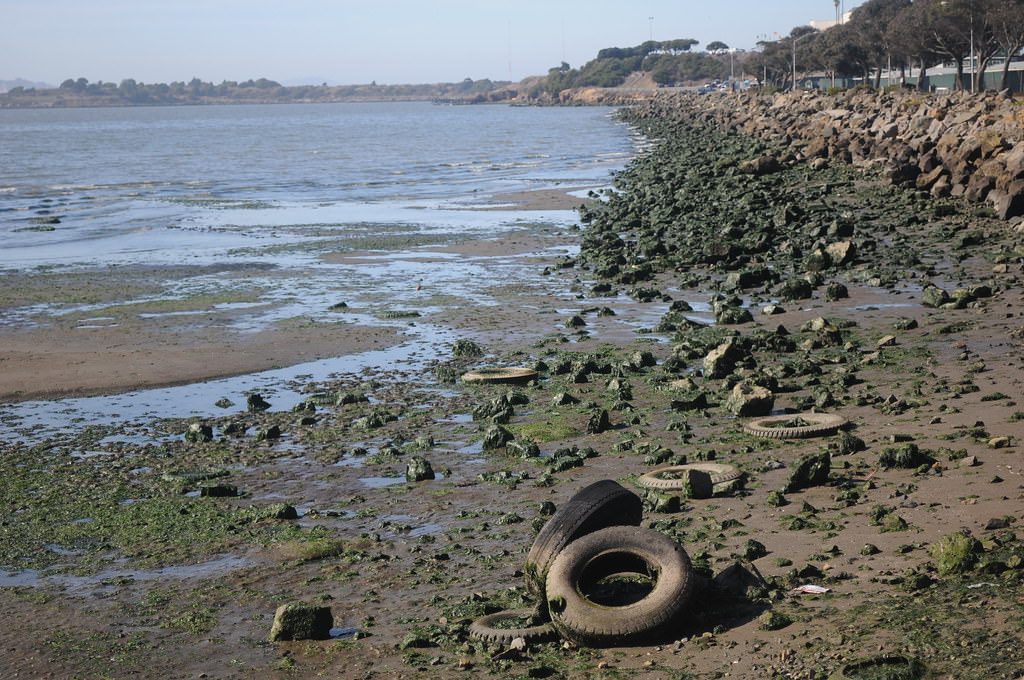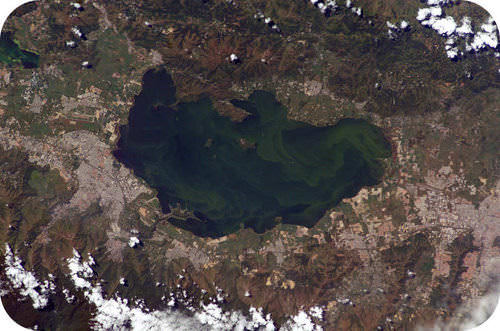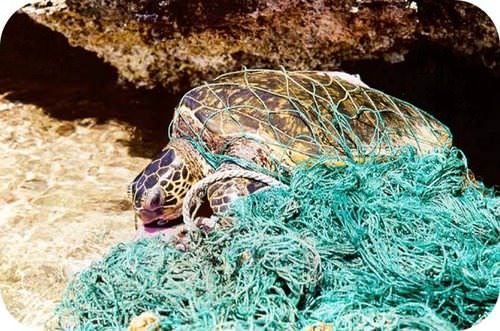水污染
章节大纲
-
Is the ocean a good dumping ground?
::海洋是一个很好的倾弃场吗?Unfortunately some people think so. A lot of garbage ends up washing ashore, and some garbage stays floating out in the ocean. can be strangled by floating trash or mistake inedible trash for food. Not only is the pollution of our oceans a problem, but also our precious freshwater resources are often polluted.
::不幸的是,有些人认为如此。 许多垃圾最终被冲上岸,有些垃圾漂浮在海洋中。 漂浮的垃圾或错误的不可食用垃圾可以扼杀食物。 我们的海洋污染不仅是一个问题,而且我们宝贵的淡水资源也经常受到污染。Sources of Water Pollution
::水污染源While to many people clean may seem limitless and everywhere, to many others this is not so. Water pollution is a serious issue facing hundreds of millions of people world-wide, having harmful effects on the lives of those people. Water is not in unlimited supply and cannot just be made fresh when it is wanted. Water is actually a limited resource , and for many people, fresh, unpolluted water is hard to find. A limited resource is one that we use faster than we can remake it. It is a resource that can be used up.
::虽然对许多人来说,清洁似乎无穷无尽,但对许多其他人来说,情况并非如此。 水污染是全世界数亿人面临的一个严重问题,对这些人的生活造成有害影响。 水不是无限制的供给,不能在需要时就新鲜。 水实际上是一种有限的资源,对许多人来说,很难找到新鲜的、无污染的水。 有限的资源是我们用得比我们用得更快的资源。 水是一种可以被耗用的资源。Water pollution happens when contaminants enter water bodies. Contaminants are any substances that harm the health of the environment or humans. Most contaminants enter the water because of humans. Surface water (river or lake) can be exposed to and contaminated by , storm water runoff , pesticide runoff, and industrial waste. This water is cleaned somewhat by exposure to sunlight, aeration, and microorganisms in the water. Groundwater (private wells and some public water supplies) generally takes longer to become contaminated, but the natural cleaning process also may take much longer. Groundwater can be contaminated by disease-producing , careless disposal of hazardous household chemical-containing products, agricultural chemicals, and leaking underground storage tanks (see Figure ).
::水污染发生于污染物进入水体时; 污染物是危害环境或人体的任何物质; 大多数污染物是由于人类而进入水中的污染物; 地表水(河流或湖泊)可能暴露于雨水径流、农药径流和工业废物,并受到这些污染物的污染; 这种水通过接触阳光、通风和水中的微生物而在一定程度上得到净化; 地下水(私人水井和一些公共供水)一般需要更长的时间才能受到污染,但自然清洁过程也可能需要更长的时间; 地下水可能受到产生疾病、不小心处置有害家用含化学产品、农业化学品和漏水的地下储水罐的污染(见图1)。Water pollution can cause harmful effects to ecology and human health. Shown is the pollution in Jakarta, Indonesia. Natural events, like storms, volcanic eruptions and earthquakes can cause major changes in water quality. But human-caused contaminants have a much greater impact on the quality of the water supply. Water is considered polluted either when it does not support a human use, like clean drinking water, or a use for other animals and plants. The overgrowth of , known as an algal bloom , can result from the runoff of fertilizer into bodies of water. This excess of nutrients allows the algae to grow beyond control, bring harm to the rest of the .
::自然事件,如暴风雨、火山爆发和地震等,可导致水质发生重大变化,但人为污染物对水供应的质量影响更大,水被视为污染,当水不支持人类使用时,水被视为污染,如清洁饮用水,或用于其他动物和植物。 肥料流入水体,即藻类开花,会造成过度生长。 这种过多的养分使得藻类生长到无法控制的地步,给其他动物和植物带来伤害。The main sources of water pollution can be grouped into two categories:
::水污染的主要来源可分为两类:-
Point source pollution
results from the contaminants that enter a waterway or water body through a single site. Examples of this include untreated sewage, wastewater from a sewage treatment plant, and leaking underground tanks.
::点源污染是由通过单一地点进入水道或水体的污染物造成的,其中包括未经处理的污水、污水处理厂的废水和漏水的地下水箱。 -
Nonpoint source pollution
is contamination that does not come from a single point source. Instead, it happens when there is a buildup of small amounts of contaminants that collect from a large area. Examples of this include fertilizer runoff from many farms flowing into groundwater or streams.
::非点源污染是污染,并非来自单一点源,而是在从大片地区收集的少量污染物聚集起来时发生的,例如,从许多农场流入地下水或溪流的肥料流失。
Effects of Water Pollution
::水污染的影响Water pollutants can have an effect on both the ecology of ecosystems and on humans. As a result of water pollution, humans may not be able to use a waterway for recreation and fishing. Drinking water can also be affected if a toxin enters the groundwater.
::由于水污染,人类可能无法使用水道进行娱乐和捕鱼,如果有毒物质进入地下水,饮用水也会受到影响。Eutrophication
::富营养化In a ecosystem, algae are the . Through , they provide glucose for the ecosystem. So, can too much algae be a bad thing? Eutrophication is an over-enrichment of chemical nutrients in a body of water. Usually these nutrients are the nitrogen and phosphorus found in fertilizers. Run-off from lawns or farms can wash fertilizers into rivers or coastal waters.
::在一个生态系统中,藻类是藻类。它们通过它为生态系统提供葡萄糖。因此,太多藻类会不会是坏事?富营养化是水体中化学养分的过度丰富。这些养分通常是肥料中发现的氮和磷。草坪或农场的径流可以将肥料洗入河流或沿海水域。Plants are not the only things that grow more quickly with added fertilizers. Algae like the excess nutrients in fertilizers too. When there are high levels of nutrients in the water, algae will grow large very quickly. This leads to overgrowths of algae called algal blooms . However, these algae do not live very long. They die and begin to decompose. This process uses oxygen, removing the oxygen from the water. Without oxygen, and shellfish cannot live, and this results in the death of these organisms ( Figure ).
::植物不是增加肥料以更快的速度生长的唯一东西。 藻类就像肥料中过剩的营养物一样。 当水中养分含量高时,藻类会迅速生长。 这会导致藻类的过度生长, 叫做藻类开花。 然而, 这些藻类不会长寿, 它们会死, 并开始分解。 这个过程使用氧气, 将氧气从水中去除。 没有氧气, 贝类无法存活, 这导致了这些生物的死亡( 图示 ) 。Certain types of algal blooms can also create toxins. These toxins can enter shellfish. If humans eat these shellfish, then they can get very sick. These toxins cause neurological problems in humans.
::某些种类的藻类盛开也可以产生毒素。这些毒素可以进入贝类。如果人类吃这些贝类,那么它们就会病得很重。这些毒素会对人类造成神经问题。Lake Valencia, Venezuela, showing green algal blooms. How did the algal bloom form? What will it do to the lake over time? Ocean Acidification
::海洋酸化Ocean acidification occurs when excess carbon dioxide in the atmosphere causes the oceans to become acidic. Burning fossil fuels has led to an increase in carbon dioxide in the atmosphere. This carbon dioxide is then absorbed by the oceans, which lowers the pH of the water. Ocean acidification can kill corals and shellfish. It may also cause marine organisms to reproduce less, which could harm other organisms in the . As a result, there also may be fewer marine organisms for humans to consume.
::海洋酸化发生在大气中二氧化碳过多导致海洋酸化时。燃烧化石燃料导致大气中二氧化碳的增加。然后,海洋吸收这种二氧化碳,降低水的pH值。海洋酸化会杀死珊瑚和贝类,还可能导致海洋生物繁殖减少,从而伤害其他生物。因此,人类消耗的海洋生物也可能会减少。Aquatic Debris
::水生碎片debris is trash that gets into fresh- and saltwater waterways. It comes from shipping accidents, landfill erosion, or the direct dumping of trash. Debris can be very dangerous to aquatic wildlife. Some animals may swallow plastic bags, mistaking them for food. Other animals can be strangled by floating trash like plastic six-pack rings. Wildlife can easily get tangled in nets ( Figure ).
::垃圾是进入淡水和咸水水道的垃圾,来自航运事故、填埋场侵蚀或直接倾倒垃圾。碎片可能对水生野生动物非常危险。有些动物可能吞下塑料袋,误以为是食物。其他动物可能像塑料六包环一样被漂浮垃圾扼死。野生动物很容易被网缠住(图 )。Marine trash can harm different types of aquatic life. Pictured here is a marine turtle entangled in a net. How can you keep this from happening? Waterborne Diseases
::水传播疾病Unsafe water supplies have drastic effects on human health. Waterborne diseases are diseases due to microscopic pathogens in fresh water. These diseases can be caused by , , , and intestinal parasites . In many parts of the world there are no water treatment plants. If sewage or animal manure gets into a river, then people downstream will get sick when they drink the water. According to the World Health Organization (WHO), diarrheal disease is responsible for the deaths of 1.8 million people every year. It was estimated that 88% of the cases of diarrheal disease are caused by unsafe water supplies.
::水媒疾病是淡水中微生物病原体引起的疾病,这些疾病可能由、、、和肠道寄生虫引起,在世界许多地方没有水处理厂,如果污水或动物粪便进入河流,下游的人在喝水时就会生病,根据世界卫生组织(卫生组织)的资料,腹泻疾病每年造成180万人死亡,据估计,88%的腹泻疾病是由不安全的供水造成的。Science Friday : Poop and Paddle: An Eco-Friendly Floating Toilet
::科学星期五:水坑和水板:一个生态友好的漂浮厕所How do wetlands filter water? In this video by Science Friday , inventor Adam Katzman describes how his toilet-boat converts human waste into cattails and clean water.
::湿地如何过滤水?科学节的录像中,发明家亚当·卡茨曼描述了他的马桶船如何将人类废物转化为尾巴和清洁水。Summary
::摘要-
Water is a limited resource, but it is often polluted by humans.
::水是一种有限的资源,但往往受到人类的污染。 -
Sources of water pollution can be grouped as point source pollution (large amounts entering through a single site) or nonpoint source pollution (small amounts entering from many sites.)
::水污染源可分为点源污染(大量通过单一地点进入)或非点源污染(少量从许多地点进入)。 -
High levels of nutrients, called eutrophication, can cause conditions that deprive fish of oxygen.
::高营养素(称为富营养化)可导致鱼类失去氧气的情况。 -
Ocean acidification occurs when excess carbon dioxide in the atmosphere causes the oceans to become acidic, which harms corals and shellfish.
::当大气中二氧化碳过多导致海洋变成酸性,从而伤害珊瑚和贝类时,就会发生海洋酸化。 -
Debris can be dangerous to aquatic wildlife.
::碎片可能对水生野生生物造成危险。
Explore More
::探索更多Use the resource below to answer the questions that follow.
::利用以下资源回答以下问题。-
Water Pollution
at
(4:42)
::水污染时间(4:42)
-
How can human sewage throw ecosystems out of balance? What nutrient cycle(s) are involved?
::人类污水如何使生态系统失去平衡?涉及什么营养循环? -
How does agriculture run-off effect ecosystems? How does this change move through the food web? What can the result be?
::农业径流如何影响生态系统?这种变化如何通过食物网?结果如何? -
How can drugs excreted by humans affect aquatic organisms? How does this affect the ecosystem?
::人类排泄的药物如何影响水生生物?这如何影响生态系统? -
What is heat pollution? What affect can this have on aquatic ecosystems? Explain your answer as fully as possible.
::热污染是什么?这会对水生生态系统产生什么影响? 尽可能充分地解释你的答复。
Review
::回顾-
Why is fresh water a limited resource?
::为什么淡水是一种有限的资源? -
What is water pollution?
::什么是水污染? -
What are two main sources of pollution of surface water?
::地表水污染的两个主要来源是什么? -
What are two main sources of groundwater pollution?
::地下水污染的两个主要来源是什么? -
What's the difference between a point source and nonpoint source of water pollution?
::水污染的点源和非点源之间有什么区别? -
What is eutrophication?
::什么是富营养化? -
Explain what causes eutrophication and how it affects the ecosystem.
::解释导致富营养化的原因,以及富营养化如何影响生态系统。 -
Explain what causes ocean acidification and how it affects the ecosystem.
::解释导致海洋酸化的原因,以及酸化如何影响生态系统。 -
What are waterborne diseases? What causes waterborne diseases?
::什么是水传播疾病?什么是水传播疾病?什么是水传播疾病的原因?
-
Point source pollution
results from the contaminants that enter a waterway or water body through a single site. Examples of this include untreated sewage, wastewater from a sewage treatment plant, and leaking underground tanks.



